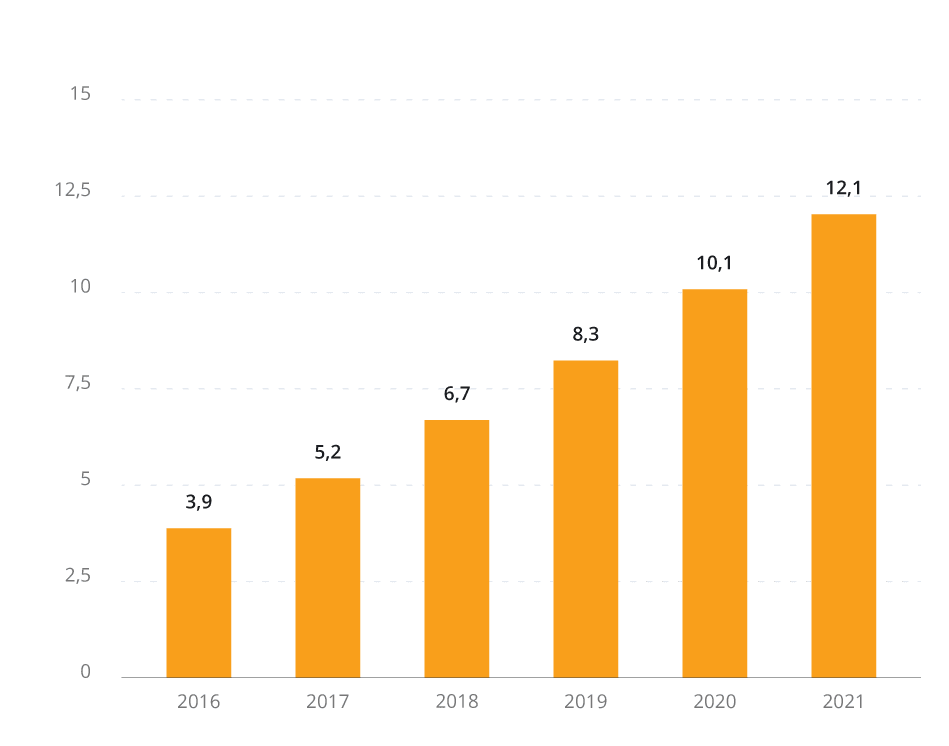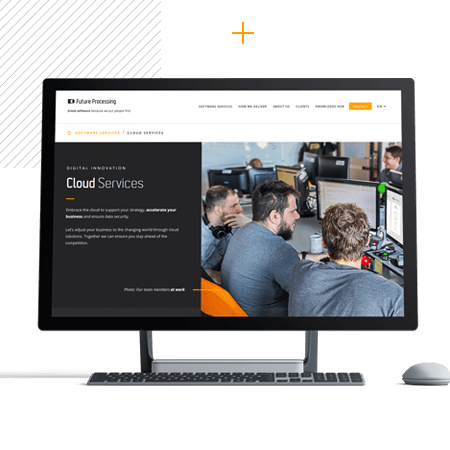
Cloud computing in Germany 2021
Cloud computing will grow significantly in 2021, both in the number of companies using cloud services and in terms of revenue volumes. New developments will dynamise the cloud business and ensure a continuation of the trend set in recent years. In addition, some framework conditions are changing which will have a significant impact on the development of cloud computing in Germany.
Studies on Cloud in the German economy
According to a study by Lünendonk and Hossenfelder, not quite half of the IT resources required in 2019 came from the cloud. However, around two thirds of the companies surveyed were currently in the process of moving applications from their data centres to the cloud.
According to Bitkom, the cloud is now almost standard: 78% of German companies used it in 2019 – in two years an increase of 5%, which will continue. And it is precisely the specialist departments that are increasingly relying on IT support from the cloud.
“There has never been more cloud than today.” Is the conclusion of IDC study on “Cloud Computing 2020+: The evolution in German companies continues”.
Almost any workload can be moved to or taken from the cloud. This diversity offers immense opportunities, because economically successful companies have long since proven that the cloud and digitalized processes are the foundation for economic success in this country too. The IDC study has revealed remarkable insights:
- 46 percent of the companies surveyed in Germany are in an advanced phase of their Cloud implementation
- 27 percent confirm hybrid clouds in productive scenarios
- 87 percent of those surveyed use multiple cloud resources, with only partial visibility of comprehensive management of all clouds
More money for cloud computing
Companies are investing more in cloud computing. The result: further increases in the turnover figures of the providers. According to the internet portal Statista (Statista GmbH: “Market Volume of Cloud Computing Services in Germany”, dated 10 September 2020), sales of cloud services – SaaS (Software-as-a-Service), PaaS (Platform-as-a-Service), IaaS (Infrastructure-as-a-Service) and storage – are expected to reach EUR 12.1 billion in 2021, from an estimated EUR 10.1 billion in the current year 2020.LC
Without change management it will not work
Changes cannot be stopped, but they can be managed successfully. This is exactly what change management is about: processes, structures, systems, strategies, values and behaviour of a company or organisation are adapted and aligned to the new, changing cloud services market conditions.
Moving into the cloud is associated with fundamental changes such as changes in perspective and agile working. More and more companies realise that professional change management is necessary to achieve a high level of acceptance among the workforce and to motivate and sensitise them to new challenges – for example in data protection. Around half of the employees are initially sceptical about new technologies, according to a Bitkom study. Around two thirds of the companies rely on targeted further training, even if the expenditure of 44 percent is estimated to be very high.
Awareness of the advantages of digital technologies is growing in the crisis
The cloud supports companies in both solving current challenges and making strategic decisions, i.e. it helps to digitalise processes and ensures the flexibility that those responsible need in different situations. COVID-19 has clearly shown decision-makers, business users and IT departments how essential it is to have a high degree of agility in business to be able to react appropriately to unexpected events. The cloud is a central component of the resilience of companies.
The corona pandemic and the associated contact bans and distance restrictions in Germany are currently causing many companies and institutions to try out new technological possibilities, for example with regard to home office, web conferences or e-learning. It can be assumed that they are meeting with understanding and increasing willingness to change on the part of their employees. After all, almost 70 percent of people are convinced that digital technologies have helped to mitigate the effects of the crisis.
Waste of cloud resources
Companies are over-designing their cloud scenarios, generating costs for cloud capacity that they do not need. This wasted computing power now has a name: cloud waste. According to the Gartner market research company (Jay Chapel: “Cloud Waste To Hit Over $14 trillion in 2019”), the cost in 2019 will be more than $14 billion; it will rise to around $21 billion in 2021. In addition, because existing server capacity is tied up unnecessarily, cloud operators need to increase their resources, resulting in additional costs. The consequences are not only financial, but also have a negative impact on energy requirements and the consumption of land and raw materials. Not least because of the growing awareness of sustainability and environmental protection, a rethink can be expected here.
Digital business models are on the rise
More and more companies are recognizing new business opportunities that they can exploit with cloud computing. For them, the cloud is not just a tool for saving costs, being more agile and networked, in other words for enterprise IT. They also develop business models with the cloud that contribute to value creation. For example, a manufacturing company offers its customers mobile applications in addition to the product, for example in the form of a virtual consulting assistant. Another approach is to offer customers leasing or sharing models rather than just selling the products. Although these forms of contract have long been commonplace in certain sectors, such as the automotive industry, other sectors have only recently begun to follow suit, the keyword being Everything as a Service (XaaS).
Security is the first commandment
It is not only since the GDPR and the US Cloud Act that Germans have been particularly sensitive when it comes to their data. In the already quoted Bitkom study, the increasingly complex requirements for data protection and IT security are among the biggest hurdles to digitization for more than half of the companies. If this aspect is considered especially with regard to the cloud, the results are the same: More than 50 percent of the participants in the Lünendonk study are uncertain about the data security of ongoing sourcing projects. The ruling of the European Court of Justice on the Privacy Shield should cause further uncertainty.
New providers are pushing into the European market
There are more and more alternatives to Amazon, Microsoft, Google & Co. Some German service providers offer IaaS or full-service clouds that are competitive in terms of both security and performance.
The EU cloud Gaia-X
GAIA-X is a project for the development of an efficient and competitive, secure and trustworthy data infrastructure for Europe, which is supported by representatives of business, science and administration from Germany and France, together with other European partners. The project was first presented to the general public at the Digital Summit 2019 in Dortmund (Germany) and has been continuously developed since then.
To protect domestic companies from the US cloud act and to ensure European data sovereignty, EU countries are currently developing a pan-European cloud, Gaia-X. This is also a way of making themselves less dependent on global players and promoting European innovation. Europe is networking existing centralised and decentralised infrastructures to create a digital ecosystem. Providers will be competent private partners. The first test runs will take place this year. Gaia-X is expected to be operational in early 2021.
Distinguishing between critical and non-critical data
Some companies address the shortcomings around data security by dividing their data and workloads into critical and non-critical data. Protection and business-critical relevance are the two main criteria in the assessment. The critical data then remains on the on-premise servers or in the private cloud, and only the rest may go into the public cloud. However, 75% of the participants in the Lünendonk survey find it difficult to make this distinction and see it as an important task for the near future.
Hybrid operating models continue to gain ground
Cloud sourcing will continue to diversify. This is because, on the one hand, organisational or technical framework conditions stand in the way of a cloud-only strategy. For example, some legacy applications will not be transferred to the cloud. Regulatory requirements, compliance rules and business management considerations can also collide with it. On the other hand, companies do not want to give up the advantages of their “best of breed” applications. Nevertheless, not least for reasons of efficiency, the various workloads and services must be formed into integrated processes. The solution to this dilemma is the hybrid cloud. The number of multi-cloud platforms will increase as the implementation level of cloud solutions increases. The figures from the Lünendonk survey show a clear trend: in 2019, 14 per cent of sourcing was already attributable to the hybrid cloud, and 81 per cent of participants were in the process of establishing hybrid operating models.
Developers focus even more on interfaces
It is crucial that all systems in a hybrid, heterogeneous IT landscape form a unit and that a management software or API prevents the need to migrate data from one solution to another. Interfaces that are too complex would also cancel out the advantages of the cloud. Moreover, the security aspect is particularly sensitive here, as it is precisely interfaces, such as those with excessively broad API authorisations, that serve as a gateway for cyber criminals. Consequently, API management tools are gaining ground, which not only make it easier to set up the interfaces, but also allow them to be better controlled.
Everything-as-a-Service (XaaS)
The demand for open hybrid as-a-service models continues to grow. Suppliers will adapt to this by adapting their business processes accordingly. One example: flexible pay-per-use models will increasingly replace classic, fixed licence and usage fees.
The Kubernetes platform (K8s) continues to triumph
World leaders in container orchestration are the Kubernetes platform and the associated cloud native technologies. In 2021, K8s will continue to shift towards hybrid and multi-cloud applications and will become the definitive cloud API standard. As the monolithic stacks are overcome, an innovation push for big data, AI and machine learning technologies is also expected.
Edge Computing strengthens decentralised computing approaches
Numerous application scenarios such as intelligent video analysis in manufacturing and industrial device communication have awakened a need for decentralised IT power, which is addressed with edge computing. Edge Computing makes computing power decentralised again and brings data processing back to the place of data acquisition. One fifth of the companies surveyed already use Edge productively. The reasons for this are mainly technological: unavoidable losses in transaction times for data over long distances are thus prevented. In addition, higher standards for data security can be guaranteed – for example, regulatory requirements to process data in one’s own network.
The market research company Gartner sees good reasons to process more data directly where it is created. The talk is of 75 per cent of data. Financial and latency reasons, for example, require sensor data from systems to be processed directly at the source. The market is already reacting and increasingly offering hybrid total solutions that combine clouding, edge computing and classic IT.
Conclusion & Outlook – Cloud computing continues to gain momentum
The cloud in its various facets has become established above all because it answers the questions of compliance, security, cost-effectiveness, scalability, agility and customer satisfaction. The cloud is available for almost all workloads and supports business and IT in almost all areas. Companies benefit with the cloud in both process optimisation and innovation, as the results of the current IDC study clearly underline. The current requirement for companies is explicitly to select the appropriate solutions for the respective workload from the continuously growing number of offers and the rapid technological development. Openness and the ability to integrate are the main requirements in order to seamlessly provide business users with resources and functionalities from internal and external sources.
Even though many companies are currently focusing on stabilising business operations in view of the ongoing COVID 19 situation, the long-term modernisation of information technology and workloads or parts of workloads will always be linked to components in the cloud. The provider landscape is also increasingly taking this change into account. However, it is no longer sufficient to offer naked cloud technology and cloud services. IDC is convinced that in next-generation IT, functions will increasingly be mapped to business platforms. This must be the common goal of providers and users. Based on the current survey, IDC estimates that the German market is well positioned for the challenges that lie ahead. The topic of “data security” in the cloud environment will remain an ongoing issue in 2021. The use of cloud services continues to increase, with hybrid cloud solutions becoming increasingly in demand. The systems should be as simple, flexible and scalable as a single public cloud, but in an open, heterogeneous IT environment. Companies are therefore well advised to get an expert on their side and find the right path into the cloud for them.
Are you thinking about building a new system based on Cloud or a modernisation of the existing one?
Enjoy the possibilities given by Cloud infrastructure.






